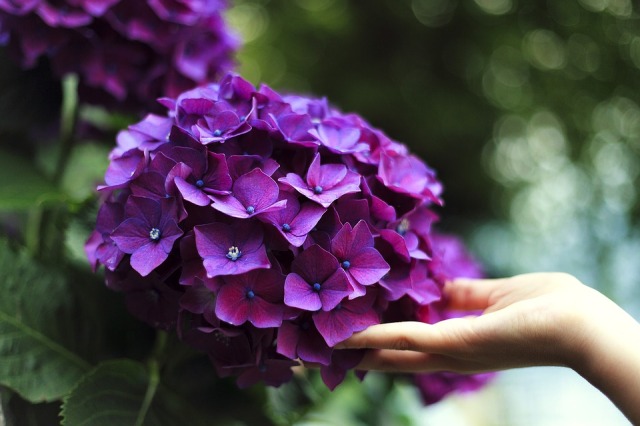It has been a dream of mine for many years now as a garden designer to be commissioned to create a large scale sensory garden for a facility such as a hospital, mall, school, senior citizen centers or treatment center. Hopefully, that dream will become a reality in the near future, but in the interim, I would like to share a few important features for creating a simple sensory garden: sight, hearing, smell, touch and taste.
Sight – Form, color and texture from visually stimulating plants such as flowering shrubs and trees, colorful and cascading fruit, herbs, and wavy ornamental grasses can bring focus and definition to this type of garden. Color, visual texture, form, movement, light, and shadow stimulate the sense of sight.
By incorporating garden favorites such as towering yellow annual sunflowers and low-growing perennial bleeding hearts you’ll get the visual attention of all garden visitors. The bright colors of orange, yellow and red draws people in to actively participate in exploring the garden.
Adding muted colors of purple, white and blue flowers such as tall and spiky lavender and low-growing, spring-blooming trillium can bring a sense of calm and serenity to any garden space.
Sound – By including features such as fountains (with their therapeutic running or gurgling water) or wind chimes and their beautiful, soul-stirring melodies stimulated by a gentle breeze, your garden can become a healing sanctuary.
Additions such as bird feeders, birdbaths and bird houses can also ensure the happiness and wellness of our feathered friends, as their merry songs and chirping enhances any garden retreat.
There are many types of plants that create their own unique melodies stimulated by natural forces like wind or rain, such as bamboo, gourds, cattails, ornamental grasses and the seed pods of the Nigella (love-in-the-mist; an annual favorite of mine).
First photo: By Roger Culos – Own work, CC BY-SA 3.0, https://commons.wikimedia.org/w/index.php?curid=40352832
Smell – By incorporating a variety of plants such as mints, lavender, thyme, nasturtiums, citrus trees and gardenias you are providing an array of scents that can offer nostalgic memories to some and informative capabilities to others. Plants such as oregano, mint, basil, rosemary, lemon balm and thyme have leaves that release their heady, fragrant scents when crushed. PlLavender and scented geraniums are perfect planted next to pathways because when brushed against, they release fragrance. Try to incorporate a seating area and place potted plants like evening stock, petunia, gardenias or trellised jasmine next to it; they will release their fragrance at night.

Touch: Plants that offer an array tactile stimulation can also be a way of welcoming visitors to your garden. As they explore, they will have a chance to feel the fuzziness of plants like lamb ears, the rigidness of fern leaves, the sharp, pointy heads and colorful flower petals of coneflower and the hardy, long and short stems of various ornamental grasses.

Taste: No sensory garden is complete without the edible plants that thrill us with their beauty, tantalize us with spicy, floral and citrus smells while encouraging us to sample a bit of nature’s bounty. By including plants such as berries, dwarf fruit trees, herbs, mini varieties of vegetables and edible flowers (nasturtiums, violets, dianthus, roses, lavender and squash blossoms) you’ll encouraging visitors to enjoy every aspect of your garden oasis…if only for a short time.
*Try incorporating plants that are non-poisonous, not treated with pesticides (use beneficial insects to deal with any potential pest problems).
























Oh my, bougainvillea is not at all fragrant.
My colleague down sout also likes the element of motion. Some designers like garden art that moves in the wind. My colleague likes plants like pampas grass that blow nicely in the wind. (Although, pampas grass is a nasty plant in the wrong situation.)
What great tips. Thank you for sharing.
Thank you…:-)